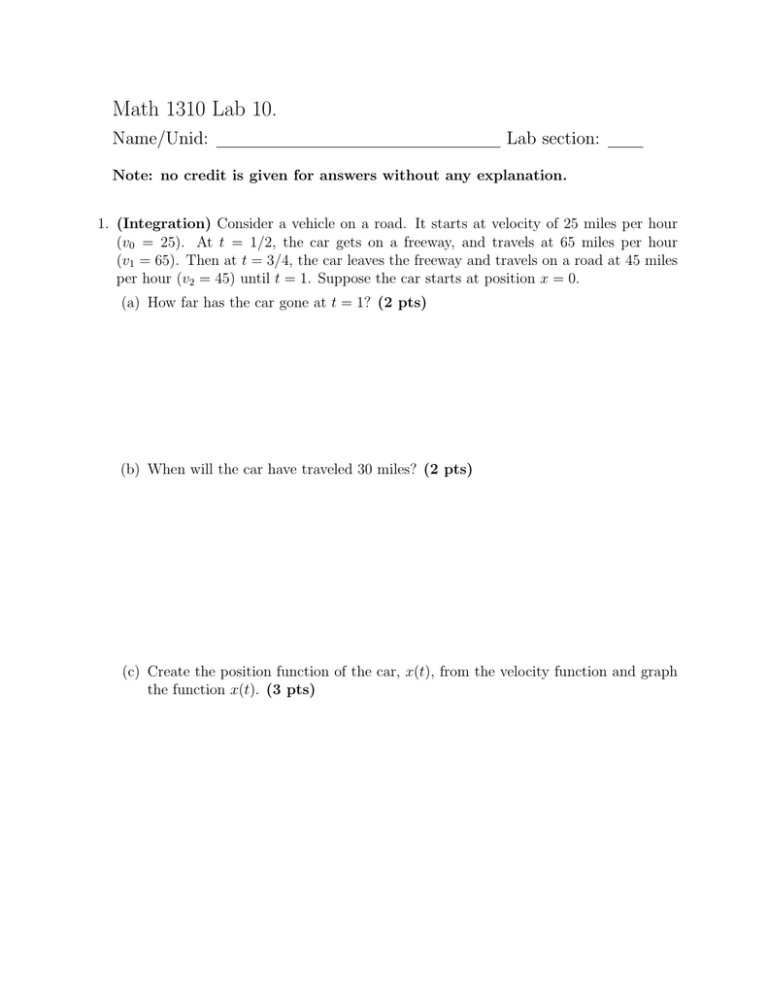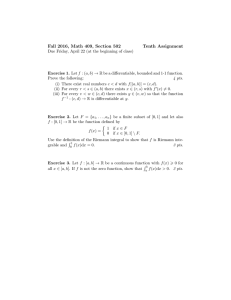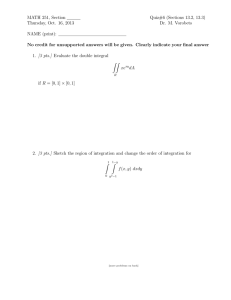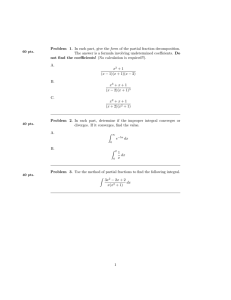Math 1310 Lab 10. Name/Unid: Lab section:
advertisement

Math 1310 Lab 10. Name/Unid: Lab section: Note: no credit is given for answers without any explanation. 1. (Integration) Consider a vehicle on a road. It starts at velocity of 25 miles per hour (v0 = 25). At t = 1/2, the car gets on a freeway, and travels at 65 miles per hour (v1 = 65). Then at t = 3/4, the car leaves the freeway and travels on a road at 45 miles per hour (v2 = 45) until t = 1. Suppose the car starts at position x = 0. (a) How far has the car gone at t = 1? (2 pts) (b) When will the car have traveled 30 miles? (2 pts) (c) Create the position function of the car, x(t), from the velocity function and graph the function x(t). (3 pts) 2. (Splitting and recombining) Suppose f and g are two continuous functions (a) If we know that Z 2 Z 2 (3f + 3)dx = 12 (f + g)dx = 6, 0 0 Use linearity of the integral to find (b) If we know that Z 3 (f + g)dx = 5, 0 Find R3 1 Z R2 0 gdx (3 pts) 1 (f + g)dx = 2, AND f (x) = 2 when x ≥ 1 0 gdx (Hint: Break up the integral using the property that pts) Page 2 Rc a f dx = Rb a f dx + Rc b f dx) (3 3. (Approximation) If f is a continuous, decreasing function, the left-endpoint and right-endpoint Riemann sums Ln and Rn give upper and lower bounds for the integral; Z b f dx ≤ Ln Rn ≤ a There is a simlar inequality if f is a continuous, increasing function. (a) Compute the 5th left-endpoint and right-endpoint Riemann sums for the integral R2 1 dx. Use these to give bounds on the value of the integral. (3 pts) 1 x (b) RCompute the 5th left-endpoint and right-endpoint Riemann sums for the integral 1 t − t2 dt. Do these sums give bounds on the value of the integral? (3 pts) 0 Page 3 4. (Antiderivatives..?) Recall that a function F is called an antiderivative for f if F 0 = f . Consider the function; ( 1 if t ≤ 1 f (t) = 2 if t > 1 (a) Sketch the graph of F (x) = F 0 (1)? (3 pts) Rx 0 f (t)dt. Is F (x) an antiderivative for f ? What is (b) What if we instead consider the following function; ( 1 if t ≤ 1 g(t) = t if t > 1 Sketch the graph of G(x) = pts) Rx 0 g(t)dt. Is this an antiderivative? What is G0 (1)? (3 Page 4






